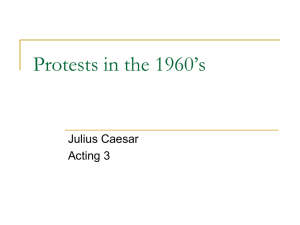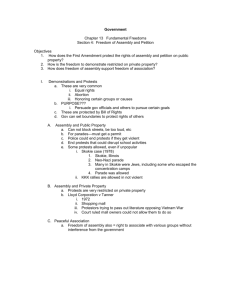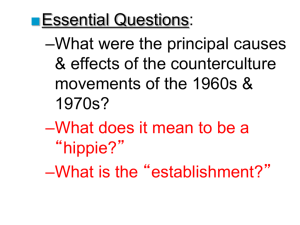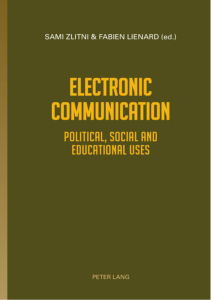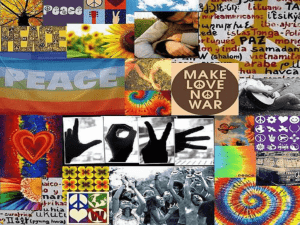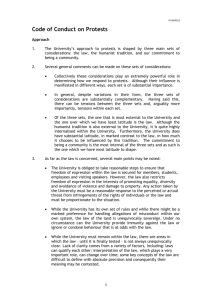Differences in Desired and Actual Outcomes between Moments in the... Movement Abstract To better grasp the process by which discrete actions in...
advertisement
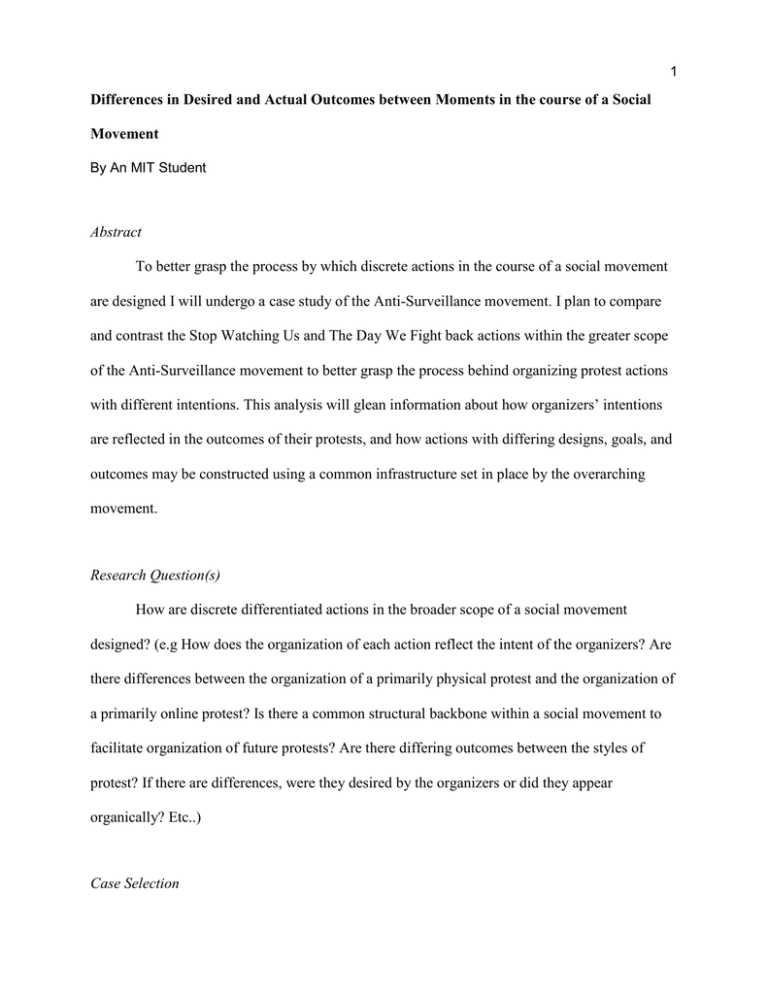
1 Differences in Desired and Actual Outcomes between Moments in the course of a Social Movement By An MIT Student Abstract To better grasp the process by which discrete actions in the course of a social movement are designed I will undergo a case study of the Anti-Surveillance movement. I plan to compare and contrast the Stop Watching Us and The Day We Fight back actions within the greater scope of the Anti-Surveillance movement to better grasp the process behind organizing protest actions with different intentions. This analysis will glean information about how organizers’ intentions are reflected in the outcomes of their protests, and how actions with differing designs, goals, and outcomes may be constructed using a common infrastructure set in place by the overarching movement. Research Question(s) How are discrete differentiated actions in the broader scope of a social movement designed? (e.g How does the organization of each action reflect the intent of the organizers? Are there differences between the organization of a primarily physical protest and the organization of a primarily online protest? Is there a common structural backbone within a social movement to facilitate organization of future protests? Are there differing outcomes between the styles of protest? If there are differences, were they desired by the organizers or did they appear organically? Etc..) Case Selection 2 Since the revelation of the ubiquity of state surveillance on a global scale by Edward Snowden in the summer of 2013, there has coalesced a movement to reduce/end state surveillance on citizens. This Anti-Surveillance movement, driven by a loose collection of extant SMOs with values aligned strongly against state surveillance of citizens along with several NGOs with a vested interest in discontinuing state surveillance, since its formation has organized several actions to protest the continuation of surveillance and government refusal to acknowledge or amend the laws and statutes that make this continued behavior legal. Out of these protests, the Stop Watching Us rally and The Day We Fight Back protests stand out, not only because of their relatively large profiles, but also because of how different these actions were designed by their organizers to be. Through a succession of interviews with the organizers of these two events I intend to learn the intentions behind each of the separate actions as well as the perceived outcomes of the organizers. Then through a separate analysis of data available online, I intend to generate a second report on the outcomes of the protests. Methods ● Interviews with protest organizers ○ I plan to contact and interview four of the organizers of the Stop Watching Us and The Day We Fight Back actions as possible. I will start with the organizers listed on the Reddit AMA posted during The Day We Fight Back protests. I will then branch off from there, interviewing people that interviewees stated were also involved in the organization efforts. ● Outcome Analysis ○ I will gather from my interviews with the organizers their opinions on the outcomes of the protests and compare their analysis of the results of the protests 3 to the outcomes that they desired when they organized the protests. ○ Second I will conduct an independent analysis of the outcomes of each protest event by using Media Cloud to garner information about the reactions of social media to the protest and quantitative outcome data gathered from the protest sites. Such quantitative data would include things such as the number of petitions signed post event or number of phone calls to Congresspeople post event, etc. ● Twitter Data ○ I plan to scrape Twitter to collect tweets during and about the TDWFB protests. This will give me information about which actors on Twitter were most active in promoting the protests, which were most retweeted (i.e. which had the most impact in informing the public), which actors were central to the network of people tweeting about TDWFB, and other such concrete data. Literature Review I plan to establish the terminology by citing a number of papers. From Diani and Mario’s "Networks and social movements," I establish the basic concept of coalitions between SMOs, citing Bandy and Smith’s “Coalitions across borders: Transnational protest and the neoliberal order,” as well as Gerhards and Rucht’s "Mesomobilization: Organizing and Framing in two Protest Campaigns," to expand on the idea. For determining outcomes, I will build from Paster, Ito, and Rosners’ “Transactions, Transformations, Translations: Metrics That Matter for Building, Scaling, and Funding Social Movements,” by defining metrics for the outcomes of the Anti-Surveillance movement based on their framework. I will use Benkler, Roberts, Faris, Solow-Niederman, and Etling’s “Social Mobilization and the Networked Public Sphere: Mapping the SOPA-PIPA Debate,” to establish basic methodology for using Media Cloud to 4 map the social/internet media reaction to social movement events. Preliminary Findings ● Public perception of the outcomes of both the Stop Watching Us rally and The Day We Fight Back protests did not match the organizers’ perception of the outcomes. ○ Analyze this based on the framework from Paster, Ito, and Rosners. Organizers may have goals in mind that are subtler or harder to measure than the what the public believes that the protests should have accomplished. ● Big name silicon valley NGO’s participated in both protest events. However during the second action they joined in the protests as a conglomerate group to conceal their individual identities. They did not want to be associated explicitly with The Day We Fight Back protests. ● Infrastructure: ○ Stop Watching Us and The Day We Fight Back were assembled by the same core group of people. ○ Other organizations were contacted/found out about the protests through several methods: ■ SMO’s in the same movement have heavy use of mailing lists for common causes. In this case the mailing list assembled around Stop Watching Us was also used to set up The Day We Fight Back. ■ Email chains between key personnel were maintained between protests. These alerted organizations that movement was afoot. ■ Other organizations than the founding ones joined the protests after discovering that petitions reflecting their beliefs already existed. (Start a 5 petition, follow) ● Design: ○ The Day We Fight Back was designed as a follow-up to Stop Watching Us to keep the political landscape aware of Surveillance. ○ The EFF and Demand Progress were the core organizations to the protests. ○ The date of TDWFB was chosen to honor Aaron Swartz as well as mark a rough 2 year anniversary of SOPA/PIPA. Interview Questions: ● When did you first become involved in the protests? Were you involved at all with Stop Watching Us or did you begin involvement with The Day We Fight Back? ● How did a group of organizations assemble around the protests? ● What aspect of organizing the protests were you involved in personally? ● Which organizations did you primarily have contact with? ● Is there anyone from these organizations who would be willing to discuss this topic with me as well? If so, would you mind introducing them? ● How did you communicate with members of other organizations? ● Who did you contact to attempt to bring them into the protests only for them to decline? Why did they turn down the invitation? ● What were your goals for the protests? Did they differ for Stop Watching Us from The Day We Fight Back? Were they met? ● What were the goals of your organization for the protests? How did they differ 6 from the goals of other organizations involved? Were these goals met? ● What have you learned from the protests? ● Does IRC get used? Mildly Annotated Bibliography (Also fairly informal. More of a to-do list. Real Annotated Bibliography will be formal I promise) The Revolutions Were Tweeted: Information Flows during the 2011 Tunisian and Egyptian Revolutions, by Gilad Lotan, Erhardt Graeff, Mike Ananny, Devin Gaffney, Ian Pearce, Danah Boyd. Reference for the Twitter work that I’m doing, especially the classification of actors on Twitter into separate categories. Social Mobilization and the Networked Public Sphere: Mapping the SOPA-PIPA Debate, authored by Yochai Benkler, Hal Roberts, Rob Faris, Alicia Solow-Niederman, and Bruce Etling. Reference to a previous example of a SMO coalition forming around a large contentious issue (in this case SOPA/PIPA). The Media Cloud visualization and tool are definitely useful for exploring the different SMOs involved in the protests as well as perhaps another way to gather data on the TDWFB protests if I feel the necessity to add more data. Wikipedia article or paper within the Social Movement Literature about the 1999 WTO Protests This should provide a third example for the formation of SMO coalitions as well as a 7 demonstration that they do not only occur during the era of social media. Twitter If I take their data I assume I need to reference them in some way. Will confirm this. The Day We Fight Back Press Release https://thedaywefightback.org/press/ Used to form introductory narrative in paper about what TDWFB set out to do and presented itself as. The Day We Fought Back: Results https://thedaywefightback.org/the-results/ Used to prove in the introduction to the case study that TDWFB was successful at getting more done than individual SMOs. Should try to corroborate the data from their results page with independent stuff if there is any as well as find examples of actions undertaken by specific SMOs independently of TDWFB for comparison. Other papers as required Pretty much anything that I find I need more specific definitions for or specific data from as I write the final paper. MIT OpenCourseWare http://ocw.mit.edu &06 / &06 1HWZRUNHG6RFLDO0RYHPHQWV0HGLD0RELOL]DWLRQ 6SULQJ 201 For information about citing these materials or our Terms of Use, visit: http://ocw.mit.edu/terms.
